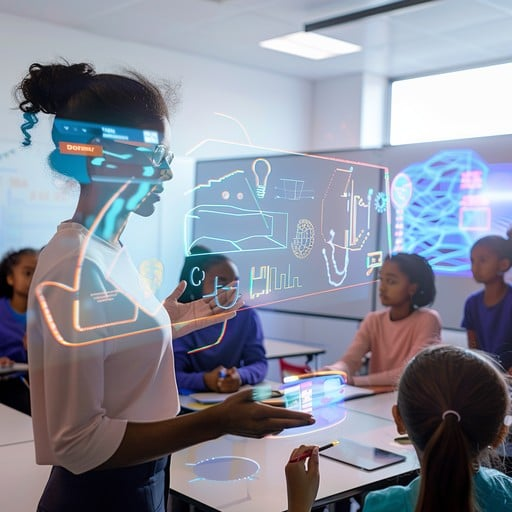- Published on
Augmented Reality Bridging Digital and Physical Worlds
- Authors

- Name
- Adil ABBADI
Introduction
Imagine walking down a bustling street, and as you approach a historic landmark, suddenly, a wealth of information about its history, architecture, and significance appears before your eyes. Welcome to the world of Augmented Reality (AR), where the boundaries between the digital and physical worlds are blurring like never before. AR is not just a technology; it's an experience that's redefining the way we interact with our surroundings, revolutionizing industries, and opening up new possibilities for entertainment, education, and more.

- The Evolution of AR
- How AR Works
- Applications of AR
- Overcoming the Challenges
- Conclusion
- The Future of AR
The Evolution of AR
AR is often confused with its cousin, Virtual Reality (VR), but there's a crucial difference: while VR immerses users in a completely digital environment, AR enhances the real world by overlaying digital information, creating a more interactive and immersive experience. The concept of AR dates back to the 1960s, but it wasn't until the 2010s that the technology started to gain mainstream attention. Today, AR is being used in various industries, from gaming and education to healthcare and architecture.
How AR Works
So, how does AR magic happen? The process involves a combination of hardware and software components:
// AR Device Components:
* Camera: Captures the user's surroundings
* Display: Shows the digital information
* Sensor: Tracks the user's movements and orientation
* Processor: Handles the complex computations
// AR Software Components:
* Tracking: Recognizes the user's environment and aligns digital content
* Rendering: Generates and superimposes digital information
* Interaction: Enables user input and feedback
Applications of AR
The possibilities of AR are endless, and its applications are transforming various industries:
Education and Training
AR is revolutionizing the way we learn by making complex concepts more engaging and interactive. Imagine biology students visualizing 3D models of the human body or history students reliving historical events in stunning detail.

Healthcare
AR is being used to enhance medical training, visualize patient data, and even guide surgeons during complex procedures.
Gaming and Entertainment
AR gaming is taking the industry by storm, offering immersive experiences that blur the lines between reality and fantasy.

Architecture and Real Estate
AR is transforming the way we design, build, and interact with physical spaces. Imagine visually exploring a property before it's even built or seeing how furniture would fit in a room before making a purchase.
Retail and Marketing
AR is changing the retail landscape by enabling customers to try out products virtually, reducing returns, and increasing engagement.
Overcoming the Challenges
While AR holds immense potential, there are still hurdles to overcome:
// Technical Challenges:
* Latency: Reducing the delay between user input and AR output
* Occlusion: Handling objects obstructing the AR view
* Lighting: Adapting to varying environmental lighting conditions
// Adoption Challenges:
* Cost: Making AR devices accessible to the masses
* Content: Creating high-quality, engaging AR experiences
* Adoption: Encouraging widespread use and acceptance
Conclusion
Augmented Reality is not just a technology; it's a gateway to a new world of possibilities. As AR continues to evolve, we can expect to see even more innovative applications across various industries. From education to entertainment, AR is bridging the gap between the digital and physical worlds, revolutionizing the way we interact, work, and live.
The Future of AR
As we look to the future, one thing is certain – AR is here to stay. With ongoing advancements in hardware, software, and content creation, we can expect to see even more widespread adoption and innovative applications. So, are you ready to experience the world in a whole new way?

